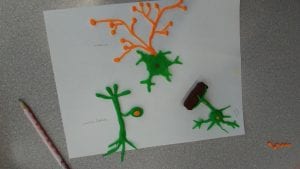Lab with Aaron and Chloe
The conclusion is written by Chloe
Purpose: Find the pH and the concentration of the acid.
Procedure:
- On a scale, measure 3.00 g of powdered Tartaric acid. Record mass into a notebook.

Measuring Tartaric acid on a scale - Warm 50.0 mL of water on a burner.

Heating water on a burner - Dilute measured Tartaric acid into warmed water. Mix with a glass rod.

Diluting Tartaric acid with water - With a funnel and filter paper, wet the filter paper with a wash bottle, so it sticks to the surface of the funnel, then dispose of the water collected. Proceed to filter the sample of diluted Tartaric acid into an Erlenmeyer flask.

Filtering sample - Prep titration area. Take a buret and fill it all the way with 0.10 M of NaOH (base). Then clamp the buret onto the stand with a magnetic stirrer.

Sample under buret - Read the initial level of each buret and record this in your notebook. The proper reading is taken from the bottom of the meniscus. If the initial reading is at exactly at zero, then report 0.00 mL.
- Take the filtered sample of Tartaric acid and measure out 10.0 mL with a graduated cylinder. Once measured, pour into a 50.0 mL beaker.

Measured 10.0 mL sample transferred into a beaker - Into the beaker of Tartaric acid, add 2-3 drops of phenolphthalein (indicator). Drop in the stir bar and place the sample onto the magnetic stirrer under the clamped buret.

Adding a few drops of Phenolphthalein into the sample - Turn on stirrer and start slowly dropping the NaOH from the buret into the Tartaric acid sample.
- Continue adding base until a very faint pink colour remains. Stop the buret and the timer. Record the final volume of the base.

Sample turning pink - To record the total base added into the sample, subtract the final volume of base and the initial volume from the buret reading.
- Repeat steps 6-10 two more times.
Materials:
| – 3.00 grams of Tartaric acid– 50.0 mL of water
– 0.10 M of NaOH – Phenolphthalein – Glass rod – Measuring scale – Weigh boat – Scoopula – Funnel |
– Filter paper– Wash bottle
– Erlenmeyer flask – Magnetic stirrer w/ a stand and clamp – Stir bar – Graduated Cylinder – 50.0 mL beaker
|
Data:
Mass of Tartaric acid: 3.01 g Tartaric acid
Initial Reading of NaOH: 0.1 mL
| Trial # | Volume of NaOH (mL) |
| 1st trial | 5.90 mL |
| 2nd trial | 5.90 mL |
| 3rd trial | 4.90 mL |
| Average Volume: | 5.60 mL |
Calculations:
Total volume of NaOH and Tartaric acid (C4H6O6): 0.0100 L C4H6O6 + 0.0056 L NaOH = 0.0156
M1V1 = M2V2
(0.10 M NaOH)(0.0056 L NaOH) = M2(0.0156 mL)
M2 (H30)= 0.036 M
Conclusion:
In conclusion, we learned how acids are found in everyday life and surprisingly, in our food! From a quick google search, it says that Tartaric acid is found naturally in grapes and in wine. In this experiment and through different procedures, we found the concentration of our acid by diluting the Tartaric acid and filtering it, and through Titration, by using a known concentration (NaOH) we find the unknown concentration of Tartaric acid. Using equation M1V1=M2V2, we find the concentration of Hydronium Ions and we used this data to find our final pH, which is 1.6. It is surprising how acidic food can be.










